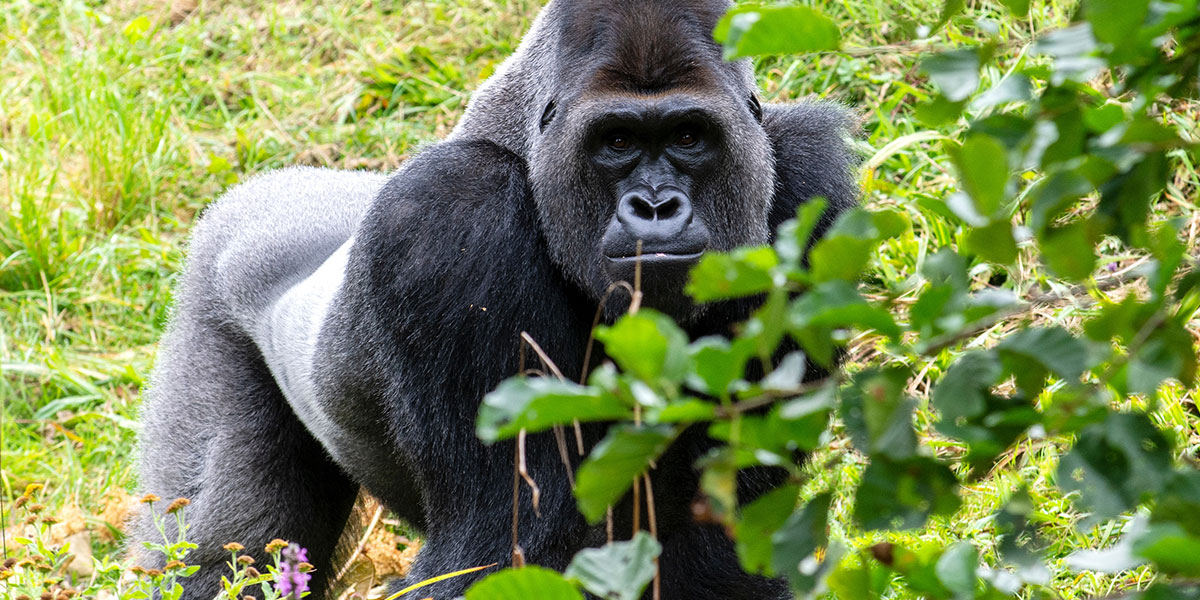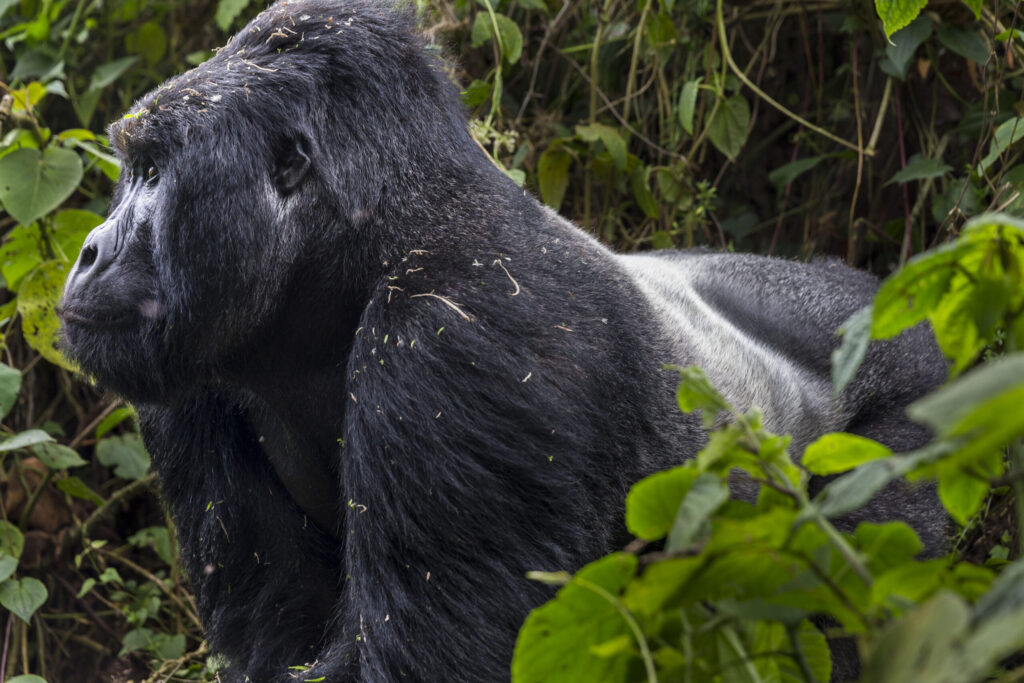Ten Facts Regarding Silverback Mountain Gorillas
Ten Facts Regarding Silverback Mountain Gorillas, Fortunately, the conservation campaign initiated by Dian Fossey has heightened awareness. In recent years, the gorilla population has risen, leading the International Union for Conservation of Nature (IUCN) to reclassify gorillas from critically endangered to endangered.
Currently, tourists in the rainforest mountains of the DRC, Rwanda, and Uganda can participate in small group treks to engage with a silverback gorilla and his family on gorilla trekking excursions for one memorable hour. These multi-day excursions are coordinated by local tour operators based in Entebbe (Uganda) and the Rwandan capital, Kigali.

The discourse project initiated by Dian Fossey has successfully heightened awareness. In recent years, the gorilla population has risen, leading the International Union for Conservation of Nature (IUCN) to reclassify gorillas from critically endangered to endangered.
Currently, tourists in the rainforest mountains of the DRC, Rwanda, and Uganda can participate in small group treks to experience an incredible hour with a silverback gorilla and his family on gorilla trekking tours. These multi-day excursions are coordinated by local tour operators based in Entebbe (Uganda) and the Rwandan capital, Kigali.
To numerous naturalists, silverback mountain gorillas represent one of the most magnificent species on Earth. Their amiable disposition and elevated intellect have become the great apes of Africa sought-after by wildlife adventure enthusiasts globally. The optimal method to witness these “gentle giants” is by participating in the daily gorilla trekking expeditions in Uganda and Rwanda.
Gorilla trekking involves a guided expedition through deep jungles to watch and interact with gorillas in their natural environment. Prior to undertaking a gorilla safari, it is advisable to familiarize yourself with the primates.
Silverbacks are male gorillas that acquire a silver coat on their backs as they mature, typically around the age of 15 years. Mountain gorillas inhabit patriarchal groups, led by a silverback, accompanied by numerous related females and their offspring. The social structures of big apes can be compared to those of primitive human families.

Here is our compilation of ten intriguing facts on silverback mountain gorillas.
There exist two species of gorilla.
Two species of gorillas exist globally: the eastern gorilla and the western gorilla. Each species is categorized into two classes. The four subspecies of gorillas are eastern mountain gorillas, eastern lowland gorillas, western cross-river gorillas, and western lowland gorillas.
Silverbacks are eastern mountain gorillas residing in the woods of the Virunga Mountains, a mountain region adjacent to Rwanda, Uganda, and Congo. Gorillas in Uganda inhabit elevations ranging from 8,000 to 13,000 feet, equivalent to the altitude from which a skydiver exits an aircraft. Silverback Mountain Gorillas possess longer and denser fur, as well as elongated arms and legs in comparison to other species. They are quadrupedal primates, indicating that they ambulate on four limbs.
They adhere to a vegetarian diet.
Silverback mountain gorillas adhere to a herbivorous diet. They consume stems, bamboo shoots, and fruits. Nevertheless, their selection of fruit is constrained by the elevated altitude of their environment.
Adult male gorillas may ingest over 18 kg of foliage each day and utilize their remarkable power to dismantle trees and trunks. For instance, they can dismantle an entire banana tree to access the delicate inner pith.
Uganda Gorillas are discerning foragers and do not excessively deplete a region for sustenance. They harvest vegetation in a manner that facilitates rapid replacement.
They hardly drink water.
Silverback Mountain Gorillas infrequently ingest water, as their diet predominantly comprises succulent plants containing moisture and morning dew. These animals obtain the necessary moisture from their dietary intake. They consume a tremendous amount of food, dedicating half of their day to eating.
Dian Fossey, an American primatologist renowned for her comprehensive research on mountain gorilla populations, stated that the primates exhibit a clear aversion to rain and appear to have an overall distaste for water.
They are tremendous and formidable.
Silverback gorillas are among the largest and most powerful primates, reaching heights of four to six feet and weighing between 135 kg and 220 kg. The tallest documented Silverback measured 6 feet 3 inches in height, with an arm spread of 2.8 meters and a chest circumference of 1.98 meters.
Silverbacks has greater strength than any person, with a strength approximately 20 times that of adult humans, with the capability to lift or throw up to 815 kg. Notwithstanding their size, they are swift runners, capable of attaining speeds between 23 and 25 mph. Furthermore, their bites are unparalleled by any other animal. Their massive canines can exert a force of 1,300 pounds per square inch, surpassing that of predatory lions, which exert 650 pounds per square inch.
They exhibit gentleness and shyness.
Silverback Mountain Gorillas possess considerable strength and size; nevertheless, they seldom exhibit their power in the wild. Rather, they are docile beings that favor foraging for sustenance and lounging during the day. Individuals who have participated in gorilla trekking in Rwanda observed that the big apes exhibit shyness and reticence in the presence of humans. However, when becoming acquainted with an individual, they exhibit friendliness and affection. Consequently, they are frequently referred to as gentle giants.
Nonetheless, Silverbacks may exhibit significant aggression when provoked or threatened. They will not hesitate to demonstrate their strength when this occurs. They frequently “charge” at perceived threats; however, the majority of these assaults are feigned. They exhibit aggression solely to provide their family with an opportunity to escape to safety.
They inhabit social groups.
Gorillas are sociable creatures who inhabit groupings known as troops. A troop typically comprises one to four adult males, several juvenile males, multiple adult females, and their offspring. The eldest and most formidable Silverback serves as the leader of the unit. Upon the death of the group’s leader, the group disbands, or a young Silverback male, typically the deceased leader’s kid, assumes control.
The size of a gorilla troop fluctuates, with the typical group including four to 10 individuals. The largest group of mountain gorillas, with 65 individuals, was discovered in Rwanda. Members possess robust associations and exhibit a high degree of synchronization in their activity patterns.
They possess intelligence.
Mountain gorillas are astute beings. Despite being less inquisitive and versatile than chimps, gorillas are capable of use tools. Researchers have noted their use of branches to assess the depth of streams and rivers, constructing ladders to assist their offspring in reaching treetops, and employing sticks as utensils when consuming ants to prevent bites.
Furthermore, Mountain Gorillas exhibit remarkable communication abilities. They have been documented producing 25 distinct vocalizations to convey distress, alarm, contentment, and aggression. A Mountain Gorilla named Koko acquired proficiency in human sign language. Throughout her lifespan, she acquired knowledge of more than 1,000 signs and comprehends over 2,000 English words.
Their nasal imprints are distinctive.
The majority of Mountain Gorillas exhibit notable differences in appearance. They vary in corporeal dimensions and facial characteristics, facilitating researchers’ identification of each. Nevertheless, at times, two primates exhibit excessive similarity. Consequently, primatologist Dian Fossey devised a method for the straightforward identification of Mountain Gorillas. She observed that each Mountain Gorilla possesses distinct nasal prints, like to human fingerprints.
Mountain Gorillas exhibit the most distinct nose prints among the four subspecies of gorillas. Consequently, these prints have become an essential component of primate research.
They can live for up to 40 years.
In the wild, a Mountain Gorilla has a lifespan of 35 to 40 years, however they frequently exceed 50 years in captivity. This is due to their abundant food supply and lack of predatory threats. Owing to their size, they possess few natural predators, with leopards being the primary exception. Nonetheless, their paramount threat is posed by humans who pursue them for hunting. Moreover, poachers frequently slaughter Mountain Gorillas for their heads, hands, and feet, which are subsequently sold to collectors.
Ten Facts Regarding Silverback Mountain Gorillas
Silverback mountain gorillas are classified as endangered.
In recent decades, the gorilla population has diminished due to three primary factors: habitat destruction, sickness, and poaching.
Forests inhabited by gorillas are being obliterated for commercial logging and agricultural purposes, compelling them to endure adverse conditions. Pathogen outbreaks also impact their populations. In 2022, 95 percent of Mountain Gorillas perished due to an Ebola outbreak in Congo. In 1994, a sickness outbreak eradicated an entire gorilla population in Gabon.
As previously stated, poachers capture gorillas for sale to affluent collectors who utilize them as trophies or companions. However, they are occasionally killed in traps intended for different species.
The discourse project initiated by Dian Fossey has successfully heightened awareness. In recent years, the gorilla population has risen, leading the International Union for Conservation of Nature (IUCN) to reclassify gorillas from critically endangered to endangered.
Ten Facts Regarding Silverback Mountain Gorillas, Currently, tourists in the rainforest mountains of the DRC, Rwanda, and Uganda can participate in small group treks to spend an incredible hour with a silverback gorilla and his family on gorilla trekking tours. These multi-day excursions are coordinated by local tour operators based in Entebbe (Uganda) and the Rwandan capital, Kigali.
